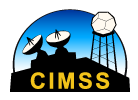A fire in northern Alberta (58.6W 113.4N) on 5 June 2015 produced two pyroCbs. This is a fire is the same that was investigated for possibly producing pyroCbs on 3 June 2015. However, on the 3 June fire there ended up not being any pyroCbs. The first pyroCb started around 23:00 UTC on 5 June, and the second starting at 02:15 UTC on 6 June. GOES 15 detects the pyroCbs at visible (.63 μm) and IR (3.9 μm) channels shown below starting at 00:00 UTC 6 June (click in animation to play). In the IR image the red pixels indicate hot shortwave IR bright temperatures exhibited by the fire.

GOES-15 0.63 μm visible (left) and 3.9 μm shortwave IR (right) images (click to animate)
The GOES-15 10.7 μm IR channel image below shows the pyroCb cloud-top brightness temperatures. The first pyroCb is seen with the coldest brightness temperature at -43.5°C at 00:30 UTC indicated by the lime green color. The second pyroCb at a temperature of -47.9°C around 03:30 UTC indicated by the lime green color.

GOES-15 10.7 μm IR image (click to animate)
Later on in the day another pyroCb formed from the same fire at 22:00 UTC 6 June 2015.GOES 15 detects the pyroCbs at visible (.63 μm) and IR (3.9 μm) channels shown below starting at 00:00 UTC 6 June (click in animation to play). In the IR image the red pixels indicate hot shortwave IR bright temperatures exhibited by the fire.

GOES-15 0.63 μm visible (left) and 3.9 μm shortwave IR (right) images (click to animate)
The GOES-15 10.7 μm IR channel image below shows the pyroCb cloud-top brightness temperature. For this pyroCb the coldest brightness temperature was -47.2ºC. This is indicated on the animation with a lime green color.

GOES-15 10.7 μm IR image (click to animate)
The image below shows the smoke plume from the fire indicated by a brown/grey color. From the image it can be seen that the smoke plume is moving southeast.

Suomi NPP True Color Image on 6 June (click to enlarge)
Smoke transport from this fire in Alberta can be followed using the OMPS Aerosol Index (AI) product. The following images are comparisons of AI images from consecutive satellite overpasses on 6 June and 7 June (images courtesy of Colin Seftor). On 6 June there is an eastward transport of the smoke while on 7 june there is a southeastward transport.

OMPS Aerosol Index images on 6 June (click to enlarge)

OMPS Aerosol Index images on 7 June (click to enlarge)
To further investigate the transport of smoke from this fire CALIPSO was used, courtesy of Mark Fromm. This is a LIDAR that captures the attenuated backscatter at 532 nm. The image below shows the LIDAR from 08 June 7:52 UTC to 08 June 8:15 UTC. The pyroCb smoke can be seen ~55 N and indicated on the image with a red color. Furthermore, it is also shown under the smoke that the troposphere bends putting the smoke in the stratosphere.

CALIPSO LIDAR image on 8 June (click to enlarge)
In addition, looking again at CALIPSO LIDAR images from 06 June. The first image below is 532 nm Total Attenuated Backscatter plot on 06 June form 19:21 UTC to 19:35 UTC. The smoke can be seen starting around 40 N extending to 51 N indicated by light grey color. The next image is the Depolarization image the smoke is indicated by a red/pink color. The third image is 1064 nm Total Attenuated Backscatter plot, the smoke on this plot is indicated by a light grey color. The fourth image is the Attenuated Ratio plot between 1064 nm and 532 nm. The smoke is indicated by the teal and purple pixels. The final image is the Vertical Feature Mask. This plot shows the different features that are in the atmosphere, the smoke is attributed as a cloud on this plot and is indicated by a light blue color.

CALIPSO 532 nm Total Attenuated Backscatter on 06 June (click to enlarge)

CALIPSO Depolarization Ration on 06 June (click to enlarge)

CALIPSO 1064 nm Total Attenuated Backscatter on 06 June (click to enlarge)

CALIPSO Attenuated Color Ratio between 1064 nm and 532 nm on 06 June (click to enlarge image)

CALIPSO Vertical Feature Mask on 06 June (click to enlarge image)
Furthermore, HYSPLIT trajectory plot (courtesy of Rene) was used to find the backward trajectory of the smoke that was found at 55 N 82W. The fire that was originally at 58.6W 113.4N and is seen closely following the red trajectory line. From this trajectory line it is seen that the smoke is see at 55 N 82W, which are the coordinates found from the LIDAR. This confirms our hypothesis that the smoke cloud found on the LIDAR was from this fire in Alberta.

Backward Trajectory using HYSPLIT on 8 June
By 09 June the smoke had reached the northern parts of the United States. The OMPS Aerosol Index (AI) product shows the smoke transport into the upper Midwest states later in the day on 08 June. The image below shows comparisons of AI images from consecutive satellite overpasses (images courtesy of Colin Seftor).

OMPS Aerosol Index images on 8 June (click to enlarge)
The GOES-13 visible channel animation below starts at 11:00 UTC on 09 June and shows the smoke transport into the upper Midwest. The trajectory of this smoke is consistent with the AI images above. Even though the AI images are on 08 June and the visible animation is on 09 June, it can be deduced from the AI images that the trajectory of the smoke is what is pictured in the animation.

GOES-13 visible image (click to enlarge)






























































